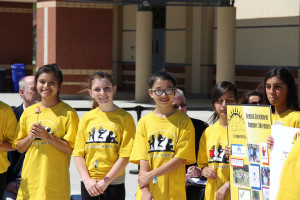Ideas for Helping New Summer Programs
Resource for Summer TA Providers
TA Providers Summer 2015 Planning Meeting
February 25, 2015
Summer Matters Outcome #1:
There are new summer learning programs created.
Role of the Summer TA Providers:
Summer TA Providers funded by the Packard Foundation are tasked to help other summer learning programs.
What does “new” mean?
In 2015, the Summer Matters Campaign has a goal that new summer programs will be started throughout the
state. “New” means they have never built or offered a summer program before; or possibly they had a summer program in
past years but it went dormant and they’re now interested restarting a summer program.
Activity
On 2/25/15, TA Providers sat in groups of 4‐5 and discussed the task of how they might provide technical assistance/support to a brand new summer program. The “host” of the table wrote ideas generated from discussions, and those have been transcribed below as a resource for TA Providers.
TA Provider Recommendations
- Seek first to understand
- Build awareness; summer learning loss (national vs. CA)
- Galvanize all opportunities happening in a community; assess community needs
- Show a “new” program an existing program: visit it; film it!
- Support Superintendents to be able to better talk about the data. What has had impact?
- Ask teachers to survey youthat the beginning of the year (they already do it at the end of each year)
- Start-‐up guides; e-‐learning (high tech, low tech, no tech); case studies of different programs’ stories; start up stories
- Developmental stages of summer program
- Getting summer learning to be part of the district’s budget
- Cohesion piece between regular day and summer learning -‐a hybrid program
- Look at resources and best practices
- Site visits; visit a high quality summer program or have parent participate in a site visit
- See data and use it as a flashlight
- Show them your toolkit
- Assist with creating a professional development plan and get equipment ordered
- Partner a “newbie” with an existing well-‐run summer program.
- Bring district leaders to visit/observe really good programs in operation.
- Develop a model with steps necessary to move the needle; key outcomes
- Unleash “parent power”; get parents to be advocates (LCAP)
- Create parent advocates; have parents participate in organize summer programs; give them enough tools to take back
- Money, money, money; 21stCentury funding; identify revenue streams; community mapping for revenue streams and what might their interest be in supporting programs
- LCAP conversations to include summer learning programs; how do you tap into LCAP?
- Advocacy work needs to be done -‐how do programs with no money get supplemental funds?
- Crowd-‐type funding campaign
- Translate materials
- Multiple, regular touch points from associate superintendent to parents:
- Site visits
- Communication
- Models of how to use money
- Messaging various stakeholders who make or advise on decisions to inform the new program and help build value
- Tailored messaging for stakeholders, school administrators and districts
- For programs with funding, provide them with resources and tools to start and maintain quality summer learning programs (i.e. timelines, locations for program, professional development, etc.)
- More campaigns like Summer Matters
- Create a follow-‐up calendar for those who say “no” at the beginning. A “touch calendar”, offer other services, create a “systematic timeline”
- Partner with summer school and provide summer learning programs afterwards, to extend the program.
- Outreach to key stakeholders (i.e. superintendents, committees, mayor, etc.) to create value relationships. Schedule appointments; be intentional



